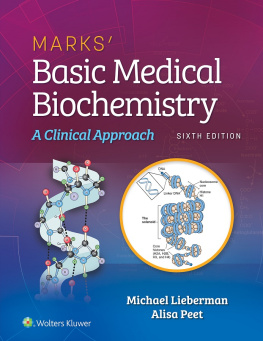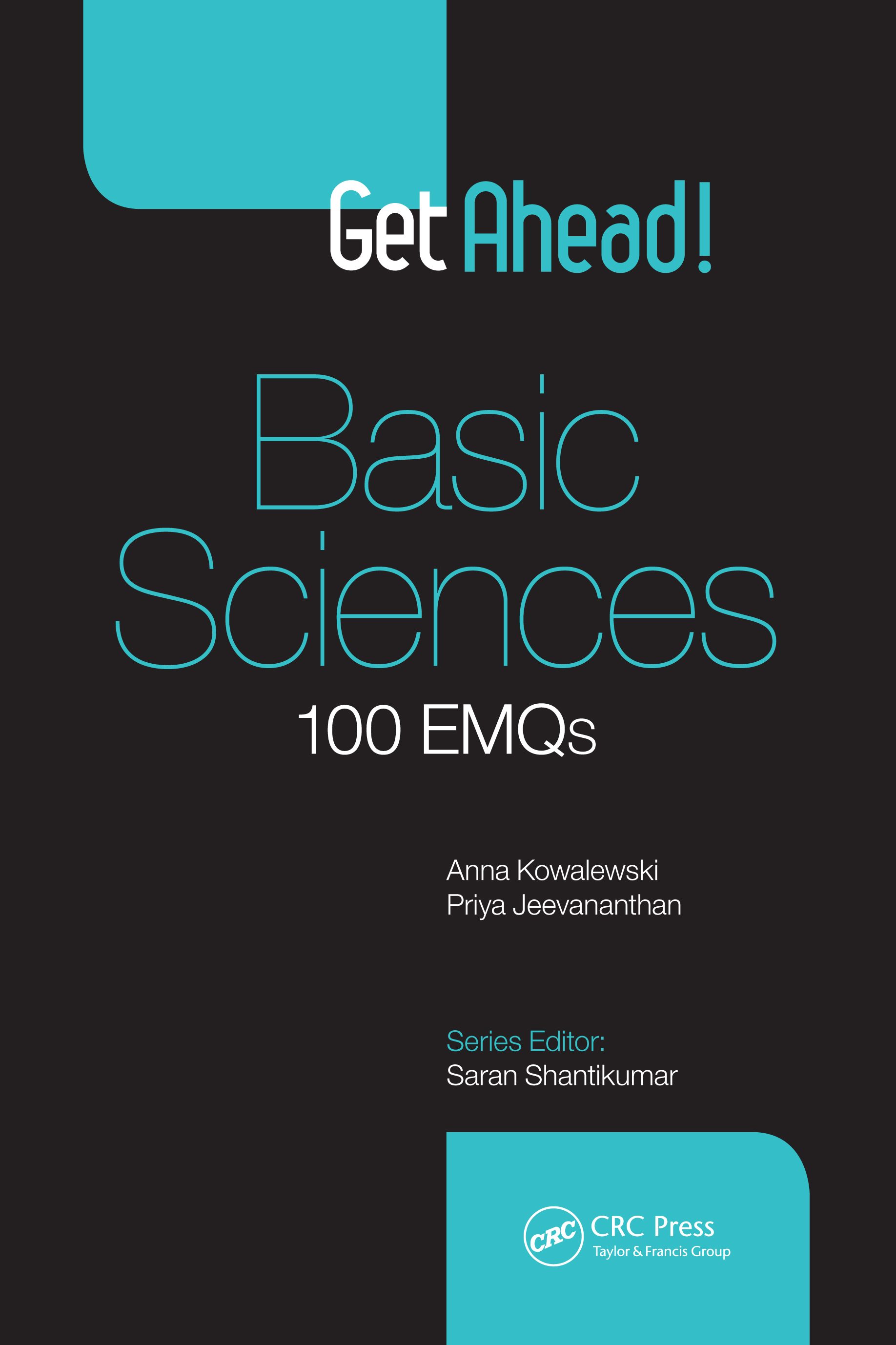Contents
Get Ahead! Basic Sciences 100 EMQs
Anna Kowalewski
Foundation Doctor, London
Priya Jeevananthan
Obstetric and Gynaecology Registrar
Queen Charlottes and Chelsea Hospital, London
Series Editor
Saran Shantikumar
Academic Clinical Fellow in Public Health
University of Warwick
Coventry, UK

CRC Press
Taylor & Francis Group
6000 Broken Sound Parkway NW, Suite 300
Boca Raton, FL 33487-2742
2017 by Taylor & Francis Group, LLC
CRC Press is an imprint of Taylor & Francis Group, an Informa business
No claim to original U.S. Government works
Printed on acid-free paper
Version Date: 20161017
International Standard Book Number-13: 978-1-4987-5103-2 (Paperback)
This book contains information obtained from authentic and highly regarded sources. Reasonable efforts have been made to publish reliable data and information, but the author and publisher cannot assume responsibility for the validity of all materials or the consequences of their use. The authors and publishers have attempted to trace the copyright holders of all material reproduced in this publication and apologize to copyright holders if permission to publish in this form has not been obtained. If any copyright material has not been acknowledged please write and let us know so we may rectify in any future reprint.
Except as permitted under U.S. Copyright Law, no part of this book may be reprinted, reproduced, transmitted, or utilized in any form by any electronic, mechanical, or other means, now known or hereafter invented, including photocopying, microfilming, and recording, or in any information storage or retrieval system, without written permission from the publishers.
For permission to photocopy or use material electronically from this work, please access www.copyright.com (http://www.copyright.com/) or contact the Copyright Clearance Center, Inc. (CCC), 222 Rosewood Drive, Danvers, MA 01923, 978-750-8400. CCC is a not-for-profit organization that provides licenses and registration for a variety of users. For organizations that have been granted a photocopy license by the CCC, a separate system of payment has been arranged.
Trademark Notice: Product or corporate names may be trademarks or registered trademarks, and are used only for identification and explanation without intent to infringe.
Visit the Taylor & Francis Web site at
http://www.taylorandfrancis.com
and the CRC Press Web site at
http://www.crcpress.com
Welcome to Get Ahead! Basic Sciences: 100 EMQs.
Here is a collection of EMQs to get you started on your road to medical school success! With any exam the key is practice, practice, practice. We cannot emphasise enough how important it is to answer as many questions as you can before your exams. This book, along with its companion volume Get Ahead! Basic Sciences: 500 SBAs, is a great way to test your knowledge, whether you are at the start, middle or scarily close to your exams.
The knowledge required to pass your exams is seemingly infinite. As soon as you learn one aspect, a thousand more immediately seem more important. To be a good doctor you have to be a lifelong learner. However, just knowing stuff is not enough. You need to know how to play the game. One way to get yourself ahead is to read as many questions as possible. The more you read, the more you realise the same questions are being asked again and again albeit in slightly different ways. Undergraduate exams are not here to catch you out.
To help your studying, the questions have been organised in two ways. The first three papers have certain topics grouped together to focus your attention on a specific area, for example, the cell or cardiology. In contrast, the last two papers are in an exam style, perfect for using as practice closer to exam time. We would suggest setting a time limit of 40 minutes for each paper, leaving you 2 minutes for each question.
In summary, practice, practice, and practice some more. Good luck.
Anna Kowalewski
Priya Jeevananthan
WRITTEN AND EDITED BY
Anna Kowalewski
Priya Jeevananthan
ADDITIONAL CONTRIBUTORS
Neel Sharma
Avishek Das
Pavithra Logitharajah
Chinedu Maduakor
Vikram Malhotra
Ian Mann
John Nehme
Naomi Periselmeris
Donna Pilkington
James Richardson
Ravnita Sharma
Naren Srinivasan
Stephanie Stone
Helen Butler
SERIES EDITOR
Saran Shantikumar
Aortic regurgitation
Aortic stenosis
Mitral regurgitation
Mitral stenosis
Pulmonary regurgitation
Pulmonary stenosis
Tricuspid regurgitation
Tricuspid stenosis
For each of the following scenarios, select the most appropriate condition. Each option may be used once, more than once or not at all.
A 58-year-old male patient presents with a history of exertional chest pain and dizziness. He notices he becomes short of breath on climbing stairs.
A 70-year-old female patient has a bobbing uvula and an early diastolic murmur best heard at the left sternal edge, 4th intercostal space on examination.
A 44-year-old female patient presents to her GP with palpitations and is found to be in atrial fibrillation. Further questioning reveals a history of a jerking movement disorder as a child. She is found to have a murmur and facial flushing on examination.
A 76-year-old male patient has a loud pansystolic murmur and lateral displacement of his apex beat. The murmur is heard best with the breath held in full expiration.
A 24-year-old male patient of no fixed abode presents to accident and emergency with a high temperature and looks unwell. He has a pansystolic murmur heard best on inspiration. Multiple scars are observed over his arms, and it is especially difficult to find a vein to cannulate.
Angiotensin-converting enzyme inhibitors
Beta-blockers
Calcium channel blockers
Loop diuretics
Methyldopa
Minoxidil
Potassium sparing diuretics
Thiazide diuretics
For each of the following scenarios, select the most appropriate medication. Each option may be used once, more than once or not at all.
A male patient has started on a drug by his GP and now reports problems sustaining erections.
A female patient has developed a swollen, tender first metatarsophalangeal joint in her left foot since starting this new medication.
A male patient has started on a new medication as an inpatient for severe hypertension by a specialist. He notices that his male-pattern balding seems to be improving with the growth of new hair.
A female patient has developed a dry irritating cough after starting a new medication.
A male patient has developed constipation and ankle swelling after starting this drug.





